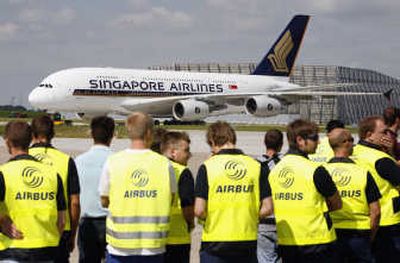Airbus chief salesman says A380’s problems are in the past

TOULOUSE, France – The worst day of John Leahy’s life, Airbus’ chief salesman says, was facing Singapore Airlines executives and telling them that the very first A380 superjumbo – already months behind schedule – would be delayed yet again.
“They just looked at me,” said Leahy, the European planemaker’s chief operating officer. “Fortunately they were speechless.”
Better late than never has been the mantra, but Leahy may soon be able to breathe easier after the handover Monday of the much-ballyhooed but problem-ridden A380, a vital step in Airbus’ efforts to recover from the vast troubles linked to the superjumbo plane.
Those delays have hurt more than just profits, denting Airbus’ reputation and allowing U.S. rival Boeing Co. to sneak into the top sales spot in 2006. But Boeing itself announced a six-month delay this week to its hot-selling 787 Dreamliner, leaving the double-decker A380 – at least temporarily – to claim the limelight.
“The symbolism of the A380 delivery is important,” said Pierre Boucheny, of Kepler Securities. “What they need to do now is show they can deliver at a decent rhythm of around 40 planes a year.”
At the delivery ceremony, speeches by Airbus’ new CEO, Thomas Enders, and Singapore Airlines CEO Chew Choon Seng, as well as John Rose, CEO of engine-maker Rolls-Royce, will be followed by a sound and light show focused on the plane that has a list price of $320 million.
Airlines usually negotiate large discounts and, as a first customer, Singapore Airlines got what Leahy described as a “good deal.”
VIP visitors will be allowed into the specially designed Singapore Airlines A380 cabin, some features of which have been kept a closely guarded secret.
Singapore has fitted its jet with 471 seats configured in three classes: 12 luxury suites on the main deck, 60 business class seats on the upper deck and 399 economy class seats on both decks. It will replace one of three Boeing 747-400 already in use on the Sydney-Singapore route.
Airbus’ showcase jet includes features such as a cocktail bar with a water fountain and a duty-free lounge. Some airlines will offer passengers the chance to freshen up with a shower, Leahy said.
Passengers on test flights claim noise levels of the A380 are low, even during takeoff at full thrust. The Rolls-Royce Trent 900 engines are the quietest now available and Airbus claims that the A380’s “noise footprint” outside is half the size of that of rival Boeing.
The A380’s inaugural commercial flight has been set for Oct. 25 from Singapore to Sydney. Singapore Airlines has auctioned all seats on the first flight on eBay, raising about $1.25 million for charity.
Turbulent period
The flashy features of what Leahy calls a “cruise ship of the sky” may help visitors forget the difficulties of the past two years.
Airbus has gone though five CEOs as multiple delays on the A380 program resulted in massive writeoffs and a restructuring plan which foresees 10,000 job cuts over four years, not to mention billions of dollars in lost profit.
Jean-Francois Knepper, of the Force Ouvriere union, said botched management of the A380 and resulting financial scandals have dented worker faith in the company.
“The feeling of being proud to work here has completely disappeared,” he said.
Morale has also been hurt by accusations that senior managers profited from knowledge about the A380’s problems to cash in on share options. A preliminary report by the French Financial Markets Authority suggests there was “massive insider trading” at Airbus’ parent European Aeronautic Defence & Space Co.
Leahy admits to selling shares in 2005 and 2006, but says he is “sure there is nothing really behind” the allegations.
The A380 represents Airbus’ bet on future demand for long-haul travel between increasingly congested hub airports worldwide. Boeing argues passengers want point-to-point journeys between smaller airports and is targeting the more lucrative market for midsized jets.
Another question is whether the A380 can turn a profit. Harald Liberge-Dondoux, aerospace analyst at Aurel Leven in Paris, reckons Airbus needs to sell 470 superjumbos just to break even.
Leahy said production will start at around 25-30 jets per year, ramping up to 45 by 2010. Sixteen customers, including British Airways, have booked 189 orders or firm commitments and Leahy says that number may exceed 200 by the end of the year.
Over the A380’s lifetime, Leahy predicts Airbus will sell “well over 800 planes” and is targeting every airline currently flying a Boeing 747.
“When this airplane is out flying, my marketing job will get a lot easier,” he said, predicting that new orders would keep pace with production.
The company got a boost Thursday with word that Airbus had signed a memorandum of understanding with Spanish tourism and transportation company Grupo Marsans to provide 61 aircraft, including four A380 superjumbos.
EADS shares also climbed following Boeing’s announcement Thursday that it is delaying initial deliveries of the 787 Dreamliner by six months, citing assembly problems. Deliveries that had been scheduled to begin next May will be pushed back to late November or December 2008.
But analysts have said Boeing’s production problems do not appear to be as severe as the snags that delayed the A380.
“It’s unfortunate that it took us so long to build it, and its unfortunate that we ran over budget, but now that’s behind us,” Leahy said.
“We have a game-changing aircraft that has an enormous demand in the marketplace.”